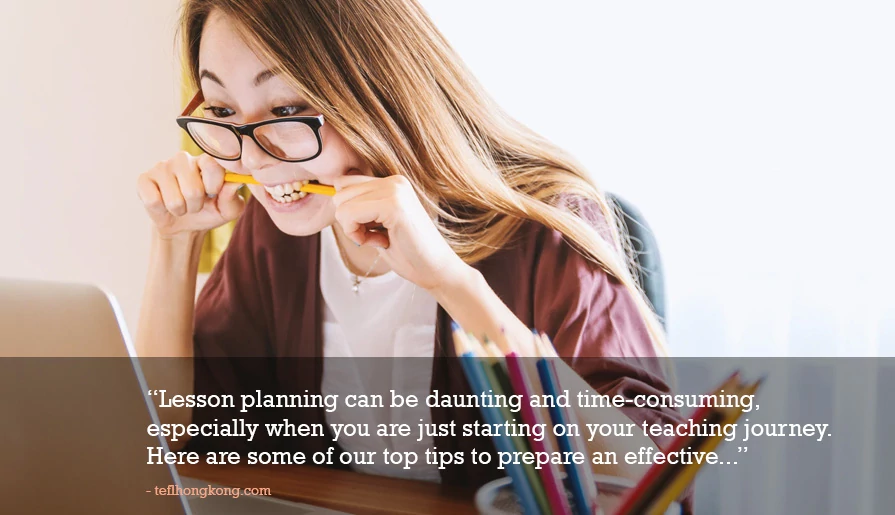
- By: Anna McIver
- In: Teaching Skills
In this article, we will provide some top tips and some general guidance on planning an effective ESL lesson to ensure both you and your English learners are happy in your classroom.
Lesson planning is undoubtedly one of the most important factors for us to consider, as ESL educators. So here we will outline few teacher’s reflections on what makes a lesson plan effective, and offer some of our top tips for things to consider before starting your plan.
Many people claim that perhaps the most important part of teaching is the lesson plan itself. Despite all the other essential ‘ingredients’ that make up a class, like teacher enthusiasm, teacher knowledge and student inputs, without a well thought out plan, things can go downhill fast!
In order to help students make progress and become successful in their use of English, an effective lesson plan is essential. Preparation or lack of preparation can make or break a class and will impact on how successful the class outcome is and how satisfied students feel.
So what do we need to create an effective ESL lesson plan and teach an excellent class?
Read on to find out!
We always find teachers themselves provide the best ideas due to their experience in the classroom, so we asked some of our ESL teachers for their input. They mentioned the following:
“Tip 1: A hook at the start of the class is a great way to get students interested, especially teenagers!”
We agree that using an image, a video clip, a song, or playing an interactive game are all great ways to start any class. This sets a positive tone for the class and makes a change from just starting with a quick review from the previous class. This also allows for latecomers (and ensures they don’t miss anything too essential) and warms the group up ready for the rest of the lesson.
“Tip 2: For me stepping away from the textbook or using it in creative ways is essential to make sure students don’t get bored.”
Often schools require teachers to follow a set of coursebook. This can often aid in planning, and is of course hugely important in preparing students for exams. However for students, constantly following the textbook, doing the tasks, checking their answers and so on can become repetitive. Bringing some change in this process is important, especially considering the different learning styles you will find in any classroom.
Why not consider a running dictation task? You can use a phrase from the textbook, but have students work in pairs to complete this interactive task by acting as scribe and reporter, and running up to the phrase stuck on the wall and reporting back to their partner. This is an effective way to practice reading, speaking and listening skills and can be adapted for any age or level.
Another easy way to ‘jazz up’ the course book is to make tasks into competitions or timed activities with a clock counting down. If you don’t have a clock or a way of displaying time, then simply shout out 1 minute, 30 seconds etc.
This encourages teamwork, and many students enjoy a bit of healthy competition! Even enlarging an activity from the textbook and making a copy can make things a bit more fun. Cut a task up into sections and then play a game. Students must run up and collect one at a time and complete in their pair or team before collecting the next one, so the textbook task is completed but in a less tedious way than normal!
“Tip 3: Taking into account the needs of your students is massively important – pair and group them carefully while considering their needs and personality.”
Adapting your class activities to suit the differing needs of students is often overlooked, but it is equally important. Although your students are more than likely to be grouped by their levels, their needs and abilities will still vary. Try to think about a range of activities covering kinaesthetic learners, auditory learners and visual learners. Also, ensure you consider the louder boisterous students and the quieter more timid individuals who may not get involved as much.
Also read: Tips and ideas to keep your young ESL learners engaged
Tips and guidance:
Lesson planning can be daunting and time-consuming, especially when you are just starting on your teaching journey. So now that we’ve heard from some teachers, let us mention our top tips for effective planning of your class?
We would suggest considering these factors before diving in:
- What are you hoping for students to achieve by the end of the class? Having a clear final objective means you know what to work towards.
- Have you considered the aim of the lesson in relation to what the students already know? Being aware of their prior knowledge and what they have studied previously is very helpful when planning, especially with new classes.
- Are you focussing on a specific skill or a range of skills? Will your plan include speaking, listening, reading or writing tasks? Knowing what you want to include and what your class needs to focus on before you start planning is crucial.
- Does your lesson plan include approximate timings? This is an important factor to ensure you can keep to time and fulfil your objectives rather than running out of time, rushing and becoming flustered. Noting down timings within your plan will ensure you know what you’re trying to achieve and in what time frame. Also bear in mind that allowing time for the unexpected is also important.
- Have you included some fun activities to ensure student engagement? Remember to consider group dynamics as well as age group.
In conclusion and our final thoughts:
Before we draw our article to a close a quick word on resources and materials. With the internet, there is now no end of worksheets and resources at your fingertips. However, always be careful when making your selection.
Make sure you check for things like spelling errors and ensure the material you choose is genuinely suited to your class and that it fits the objectives of your lesson plan. Sometimes it is worth spending the additional time and creating your own resources from scratch to ensure they’re exactly what you need.
Finally don’t forget that your fellow teachers are great help at whatever school you work! They will have lots of ideas, resources and experience to offer you, so don’t be afraid to ask for help. Also, remember no one is perfect, and all teachers have classes that go a bit wrong! This is inevitable and is something to reflect on and learn from rather than worry about.
Try to enjoy both the process of planning your classes as well as teaching them and little by little you will gain confidence and planning will become easier. We wish you the best of luck with your ESL career whether you’re starting out or if you’re an experienced teacher.
Please Share:This article was originally published on December 19, 2019 and was last updated on February 12, 2020.
Courses We Offer:

1. CertTESOL: Certificate in TESOL
A level 5, initial teacher training qualification for new and experienced teachers, enabling you to teach English anywhere in the world. The course is equivalent to Cambridge CELTA.
Learn More
Developed by our Trinity CertTESOL experts, for a comprehensive, self-paced learning experience. Earn an internationally recognized certificate and master essential teaching skills, accessible globally 24/7.
Learn More